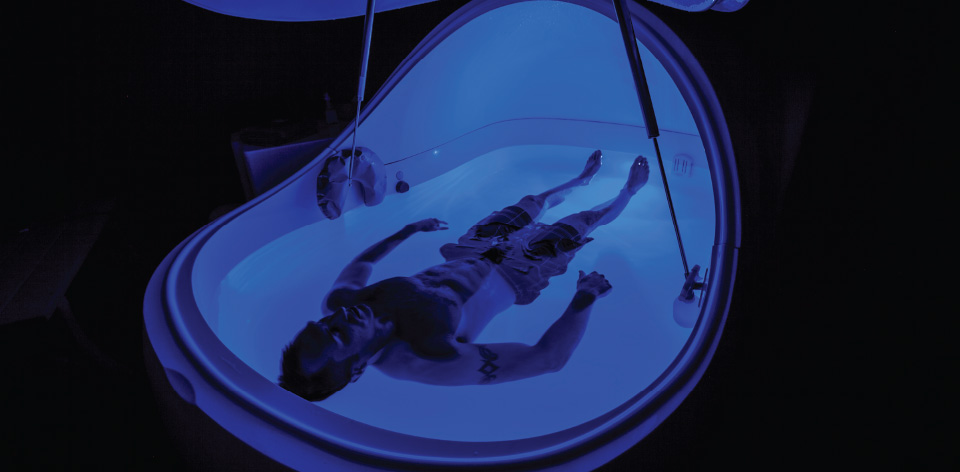The Hype of Hydrotherapy

If someone approached you raving about a method of therapy that could offer “an out of body experience,” chances are you might turn and run the other way.
As odd as it may sound though, zero gravity, sensory-deprivation pods are gaining momentum on the therapeutic science front. With a distinct approach to relaxation and recovery, flotation therapy started as an experiment formulated years ago by neuroscientist John Lilly. The scientist was fascinated by the brain’s response to eliminating sensation, its reaction to disconnecting from one or more of your senses (i.e. touch, smell, sight, etc.).
Many neuroscientists believe that separating yourself from your senses for a short period may enhance one’s ability to cope with external stressors. Sensory deprivation therapy has been around for decades, but it has recently gained recognition for its success rate in treating military personnel diagnosed with post traumatic stress disorder (PTSD).
More benefits lie beyond the sensory-related aspects of the therapy though. Many athletes and active populations are using float sessions as a quick recovery method, partly because Epsom salt concentrations are so high. Due to its simple nature, floatation therapy has also struck a chord with those who embrace natural medicine.
Isolation float tanks are generally filled with 1,100 pounds of Epson salt mixed in with 200 gallons of filtered water. This salt-water blend is enough to create buoyancy, enabling you to experience a zero gravity feeling while floating.
I must admit: the thought of relaxing while in a state of levitation had me bouncing around, wanting to try a float. I had to delve in a bit deeper. So I reached out to Jen Wylie, owner of AQUATonic Float Spa, to help calm my curiosity.
It’s easy to have your interest piqued by this modern form of therapy. My first session in the float pod certainly helped reduce my stress levels. I personally enjoyed the relaxed mental state I achieved once I was able to slow my thoughts. It was a bit difficult settling into the feeling of floating (as I’m used to sinking like a log in water), but my initial unease was quick to drift away. Ten minutes passed, the music faded, and the water settled into complete silence. The pitch black darkness unlocked some vivid visual thoughts. My mind was as scattered as a Netflix menu. Once I centered my thoughts, I was able to sink deeper into slumber.
My body felt weightless and relaxed beyond comprehension. It’s not everyday you can take gravity out of the equation. I toweled off with an advanced level of total mind and body rejuvenation I had never felt before.
While I’m a stark advocate of manual therapy for advanced physical healing and body maintenance, I was taken back by the impact hydrotherapy had on me after only one session. Busy, active, and stressful lives come with a steep price. The revitalizing oasis that is floatation therapy is one way to help re-invigorate and re-habilitate those that carry a heavy load.
Q/A with AquaTonic Float Spa owner Jen Wylie
Q: What is AquaTonic Float Spa?
A: AquaTonic Float Spa is a flotation therapy facility. We offer state-of-the-art flotation tanks (pods) to maximize your R.E.S.T. (Restricted Environmental Stimuli Therapy) experience. This R.E.S.T. principle is just a modernized term for sensory deprivation therapy.
Q: What are the benefits of flotation therapy?
A: Through an advanced relaxation method, R.E.S.T. offers an ultimate healing experience. When you eliminate one or more of your five human senses, the responses your body gives back are often very positive. Float sessions can significantly help stress levels decrease, easing aches and pains in the process. While most people use our float tanks to remedy aches and pains, some find it helps pique their creativity. The complete isolation from light, sound, and touch allows your mind to reach new levels of consciousness. This cognitive response allows you to channel your creative thought processes a lot more freely. Float therapy is a seamless transition from the practice of meditation—think of it as an outlet to reach new levels of physical relaxation and mental healing.
Q: What should someone expect during their initial float?
A: Float sessions range from 30 minutes to 2 hours. The one-hour float sessions are recommended to start. Once you are comfortable in the float pod, you will be greeted with relaxing music for the initial 10 minutes to prep you for the silence that follows for the next 45 minutes. When the session concludes, light music will ease you out of your deep, relaxed state.
Q: How many sessions should you try before you feel desired outcomes?
A: Most people experience benefits during their first session—reporting improved sleep, deeper relaxation, and less stress. However, the third session is usually the breakthrough session. You’re able to center your focus while easily directing any distractive thoughts away.
Q: What demographics would benefit the most from this form of therapy?
A: We have a wide audience, from writers to athletes. For writers, it can help channel the creative areas of your brain and for athletes it’s a great muscle recovery method. Because it’s a lot harder than it seems to disconnect yourself completely from external stimulus, much of our clientele come from working class citizens looking to escape the noise of life—even for a moment.






